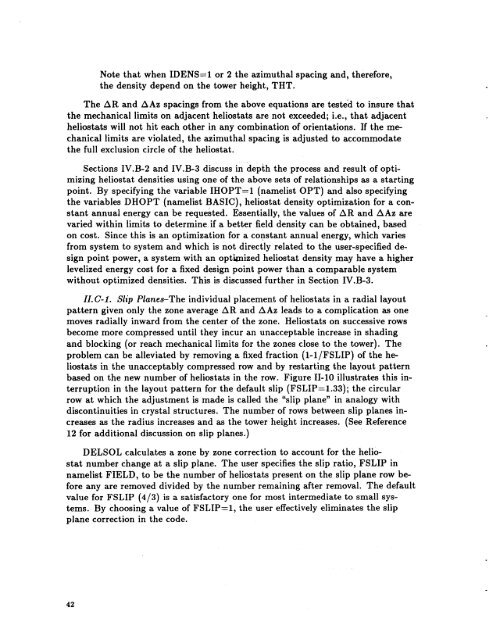A User's Manual for DELSOL3 - prod.sandia.gov - Sandia National ...
A User's Manual for DELSOL3 - prod.sandia.gov - Sandia National ...
A User's Manual for DELSOL3 - prod.sandia.gov - Sandia National ...
Create successful ePaper yourself
Turn your PDF publications into a flip-book with our unique Google optimized e-Paper software.
Note that when IDENS=l or 2 the azimuthal spacing and, there<strong>for</strong>e,<br />
the density depend on the tower height, THT.<br />
The AR and AAz spacings from the above equations are tested to insure that<br />
the mechanical limits on adjacent heliostats are not exceeded; i.e., that adjacent<br />
heliostats will not hit each other in any combination of orientations. If the me-<br />
chanical limits are violated, the azimuthal spacing is adjusted to accommodate<br />
the full exclusion circle of the heliostat.<br />
Sections 1V.B-2 and 1V.B-3 discuss in depth the process and result of opti-<br />
mizing heliostat densities using one of the above sets of relationships as a starting<br />
point. By specifying the variable IHOPT=l (namelist OPT) and also specifying<br />
the variables DHOPT (namelist BASIC), heliostat density optimization <strong>for</strong> a con-<br />
stant annual energy can be requested. Essentially, the values of AR and AAz are<br />
varied within limits to determine if a better field density can be obtained, based<br />
on cost. Since this is an optimization <strong>for</strong> a constant annual energy, which varies<br />
from system to system and which is not directly related to the user-specified de-<br />
sign point power, a system with an optimized heliostat density may have a higher<br />
levelized energy cost <strong>for</strong> a fixed design point power than a comparable system<br />
without optimized densities. This is discussed further in Section 1V.B-3.<br />
11. C-I. Slip Planes-The individual placement of heliostats in a radial layout<br />
pattern given only the zone average AR and AAz leads to a complication as one<br />
moves radially inward from the center of the zone. Heliostats on successive rows<br />
become more compressed until they incur an unacceptable increase in shading<br />
and blocking (or reach mechanical limits <strong>for</strong> the zones close to the tower). The<br />
problem can be alleviated by removing a fixed fraction (1-l/FSLIP) of the he-<br />
liostats in the unacceptably compressed row and by restarting the layout pattern<br />
based on the new number of heliostats in the row. Figure 11-10 illustrates this in-<br />
terruption in the layout pattern <strong>for</strong> the default slip (FSLIP=1.33); the circular<br />
row at which the adjustment is made is called the “slip plane” in analogy with<br />
discontinuities in crystal structures. The number of rows between slip planes in-<br />
creases as the radius increases and as the tower height increases. (See Reference<br />
12 <strong>for</strong> additional discussion on slip planes.)<br />
DELSOL calculates a zone by zone correction to account <strong>for</strong> the helio-<br />
stat number change at a slip plane. The user specifies the slip ratio, FSLIP in<br />
namelist FIELD, to be the number of heliostats present on the slip plane row be-<br />
<strong>for</strong>e any are removed divided by the number remaining after removal. The default<br />
value <strong>for</strong> FSLIP (4/3) is a satisfactory one <strong>for</strong> most intermediate to small sys-<br />
tems. By choosing a value of FSLIP=l, the user effectively eliminates the slip<br />
plane correction in the code.<br />
42

















